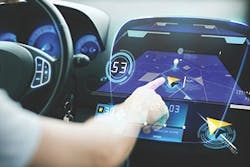For much of the automobile’s history the entertainment system was limited to a radio. Vehicle communication between the car and driver was limited to a few warning lights on the dashboard. Today, cars communicate not only with the driver but the automaker, too. The infotainment systems resemble tablet computers with touchscreen interfaces. Yet, as classic rock suggests, “You ain’t seen nothing yet.”
Today’s cars are connected and computerized, combining numerous high-tech buzzwords — Internet of Things and cloud computing — while providing for greater safety, easier navigation and as a result making for an all around smarter car. It all comes together in something called telematics, which integrates these various systems together. For the driver, this means much of the information about the car is just a touchscreen away, while for those on the auto repair and service side, it can allow for easier access to crucial information.
A recent IHS Automotive research study, Telematics Systems and Services Report, noted the market has reached a point where all OEMs have a telematics market strategy, while the report highlighted several forces will drive the industry in the next decade. These include the increased demand of seamless wireless connectivity by drivers and passengers, as well as the manufacturers’ need to wirelessly connect to digital car capabilities, and most importantly the government’s intentions to reduce fatal accident rates.
“Telematics have come a long way, and it is part of the overarching trend in the connected car,” said Anna Buettner, manager of research at IHS Automotive. “This includes advanced driver-assist features, a human machine interface (HMI) and features that will help take us to an autonomous vehicle.”
A Safer Drive
One of the greatest selling points for telematics is it can help provide a greater sense of safety, especially as the car can alert a central system if there is a problem. General Motors has long led the way via its OnStar program, but other vendors have followed suit.
“Safety and security was the starting point of telematics,” said Praveen Chandrasekar, mobility research manager at Frost & Sullivan. “OnStar’s vision when it was formed was to create a emergency response system using the latest in communication technology. The critical features of almost every telematics system in the market are automatic collision notification, emergency assistance, breakdown assistance and stolen vehicle tracking (SVT) and recovery. In fact, one of the reasons LoJack’s business started to decline was the growth in OEM telematics with SVT feature.”
Telematics help direct first responders in a crash, but the same system can also help alert drivers to potential problems big and small.
“Maintenance is also huge,” Buettner said. “It may not be the most interesting thing to the consumer, but today’s telematics can keep drivers updated when the car needs servicing.”
What was just the basic warning light has transformed to a full diagnostic system that can alert drivers, and, in the shop, help techs quickly find a problem. The days of merely listening to the engine are truly in the rear view mirror as the telematics help ensure problems are found and more easily resolved.
Touch and Go
The core of the system for most drivers will be the touchscreen display in the dash. Studies have suggested the interface is not the most intuitive, and the interface could get a facelift sooner than later. In some cases, the touchscreen could get larger with upcoming models.
“Despite usability issues — with resistive touchscreens with low-horsepower processors — the industry is truly looking to settle down on touchscreens, but the trend is to move toward capacitive touchscreens and ones with screen sizes well over nine inches,” Chandraskar said. “Another trend is the migration toward portrait mode central displays — Volvo Sensus to Tesla to new Toyota system on the Prius Prime — because it allows for a far better user interface that is intuitive and tablet-like.”
One issue that may not be resolved is touchscreen interfaces will likely become anything but standard, even among the same brands.
“The user interface for telematics isn’t likely to become standard anytime soon,” Buettner said. “Android Auto and Apple Carplay could change this a bit, as consumers expect to see these to be the same regardless of the car.”
Security Concerns
There are a few other notable concerns when it comes to telematics, with cybersecurity being among the greatest.
“Security and safety will also have to be balanced with any privacy concerns,” added Buettner, who noted while telematics make it easier for first responders in an accident, it also increases the likelihood that cars can be more easily tracked or as was seen in a high profile incident last year, even hacked.
“The cars can communicate with different entities, and right now, there is not enough security to protect the onboard systems,” warned Aaron Lowe, senior vice president for regulatory and government affairs at the Auto Care Association. “The control portion is not protected.”
The concern, according to Lowe, is that just as a home computer can be hacked, so too could the systems on the vehicle. At present, there is no firewall to protect the computerized systems.
“If someone can infiltrate the vehicle, they can take control of it, and this is something manufacturers need to address,” Lowe added.
Then there are the other factors related to privacy, as information about the car can be relayed to the dealer — often to alert of potential problems, but at issue is how much is actually being sent.
“The other concern is that the information that is being transmitted is done without the consent of the driver,” Lowe noted. “The owner should be able to know what is being transmitted. There should be more transparency, and owners should be able to control where the data is sent — such as if they want it to go to an independent repair shop they trust, as opposed to just the dealer.”
Telematics and Fleet Operations
Telematics continue to play an important role in fleet operations, both in regard to daily operations, but also in terms of maintenance.
“Most new heavy-duty vehicles are equipped with a telematics system from the vehicle manufacturer,” said Robert Stevens, EMEA category director for telematics at Delphi Produce & Service Solutions.
“These VM systems provide varying levels of information for a single make of vehicle,” Stevens added. “They are also typically only available to the vehicle dealership for service purposes. The fleet operator may also have access, but it may be limited.”
Aftermarket telematics can provide a single interface that works with most makes of vehicles. Moreover, this information can be used by the fleet operator as well as their in-house, or independent aftermarket repair facilities, and this further allows a more level playing field between the dealership and the independent aftermarket repairer.
“A telematics system can facilitate scheduled maintenance as well as provide indications of problems before they become significant repairs,” Stevens said. “One of the basic functions of telematics allows the manufacturer’s maintenance schedule to be downloaded for the vehicle.”
This schedule, combined with the actual live mileage from the vehicle, allows the vehicle owner and those servicing the vehicle to proactively arrange scheduled maintenance for the vehicle.
“The vehicle owner receives an alert via text, email or app notification that scheduled maintenance is due soon,” Stevens said. “This helps the vehicle owner to avoid missing or delaying scheduled maintenance, which helps increase the reliability of the vehicle. The repair garage also receives an alert that scheduled maintenance is due soon, which helps the repair garage ensure the correct personnel and tools are available when the work needs to be done.”
The Road Ahead
Despite the concerns, for the upcoming 2017 year models and beyond, telematics will likely only play a greater role within the car.
These features will allow the car to become more like an appliance, and as the world of consumer electronics (CE) and the automobile continues to blur — automobiles and drivers will continue to benefit from it.
“There is significant influence from the CE world, including the ability to pull content from the cloud,” Buettner explained. “The fact that cars are not running on 4G LTE mobile networks is also ensuring the data can reach the cars. Until recently, the pipe wasn’t big enough, but that is changing.”
As a result this could include several key areas of improvement Chandraskar suggested.
Prognostics: “The ability for the vehicle telematics system to detect component and system failures before they occur and direct the customers to the nearest dealership,” Chandraskar said. “GM is currently the only OEM that offers this feature on its LTE OnStar program called Driver Assurance. We expect this year many other automakers will develop this capability as a crucial way to reduce recall rates and decrease warranty spending.”
Over-the-Air Updates: “Popularly referred to as a software-defined car, this is the Tesla-like functionality where software residing in the vehicle systems can be updated over the air,” Chandraskar added. “Where Tesla differs and has an advantage is the lack of dealerships, which allows them to push new functionalities (e.g. user interface upgrades) to new features (e.g. autopilot) directly to customers. Other OEMs like Ford have started on WiFi-enabled over-the-air software updates only, and in 2016, we expect more automakers to join this fray as it grows customer loyalty.”
HMI features: “The heads-up display and voice recognition will continue to grow,” Chandraskar noted. “Heads-up displays, especially supporting advanced driver assistance systems and automated driving features, will grow in the market.”
As a result of these improvements, experts agree telematics will continue to be crucial because the external communications, real-time data in/out and over-the-air updates to heal and bring in new functionalities will be facilitated by telematics that are crucial for automated driving.
About the Author

Peter Suciu
Peter Suciu is Michigan-based writer and NOLN freelance contributor who has contributed to more than four dozen magazines, newspapers and websites. He lives in the land of cars not far from one of Henry Ford's estates.
